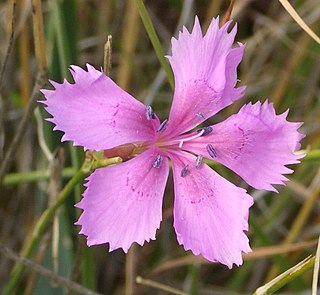
The bearded vulture, also known as the lammergeier or ossifrage, is a bird of prey and the only member of the genus Gypaetus. Traditionally considered an Old World vulture, it actually forms a minor lineage of Accipitridae together with the Egyptian vulture, its closest living relative. It is not much more closely related to the Old World vultures proper than to, for example, hawks, and differs from the former by its feathered neck. Although dissimilar, the Egyptian and bearded vulture each have a lozenge-shaped tail—unusual among birds of prey.

The bearded seal, also called the square flipper seal, is a medium-sized pinniped that is found in and near to the Arctic Ocean. It gets its generic name from two Greek words that refer to its heavy jaw. The other part of its Linnaean name means bearded and refers to its most characteristic feature, the conspicuous and very abundant whiskers. When dry, these whiskers curl very elegantly, giving the bearded seal a "raffish" look.

Dianthus is a genus of about 300 species of flowering plants in the family Caryophyllaceae, native mainly to Europe and Asia, with a few species extending south to north Africa, and one species in arctic North America. Common names include carnation, pink and sweet william.
Marcus Valerius Messala Barbatus was a politician at the beginning of the Roman Empire; he was notably consul in AD 20. He was also the father of Messalina, the wife of the Emperor Claudius.

Dianthus barbatus, sweet William, is a species of flowering plant in the carnation family, native to southern Europe and parts of Asia. It has become a popular ornamental garden plant. It is a herbaceous biennial or short-lived perennial plant growing to 13–92 cm tall, with flowers in a dense cluster of up to 30 at the top of the stems. Each flower is 2–3 cm diameter with five petals displaying serrated edges. Wild plants produce red flowers with a white base, but colours in cultivars range from white, pink, red, and purple to variegated patterns. The exact origin of its English common name is unknown but first appears in 1596 in botanist John Gerard's garden catalogue. The flowers are edible and may have medicinal properties. Sweet William attracts bees, birds, and butterflies.

The Bornean bearded pig, also known ambiguously as the bearded pig, is a species in the pig genus, Sus.

Plectranthus barbatus, also known by the synonym Coleus forskohlii and vernacular names forskohlii and Indian coleus, is a tropical perennial plant related to the typical coleus species. It produces forskolin, an extract useful for pharmaceutical preparations and research in cell biology.
Gonolobus cundurango, is an unresolved name for a plant that might be a vine of the milkweed family.
Saint Barbatus of Benevento, also known as Barbas, was a bishop of Benevento from 663 to 682. He succeeded Hildebrand in this capacity. He assisted in a church council called by Pope Agatho in Rome in 680 and in 681 attended the Third Council of Constantinople against the Monothelites.

The whiskered myiobius or bearded flycatcher is a species of bird in the family Tityridae, having previously been included in Tyrannidae. A number of taxonomic authorities continue to place with the flycatchers. The whiskered myiobius is found in Brazil, Colombia, Ecuador, French Guiana, Guyana, Peru, Suriname, and Venezuela. Its natural habitats are subtropical or tropical moist lowland forests and heavily degraded former forest.
Gonolobus campii is a species of plant in the family Apocynaceae. It is endemic to Ecuador. It is threatened by habitat loss.

Gonolobus is a genus of plant in family Apocynaceae, first described in 1803. It is native to South America, Central America, Mexico, the West Indies, and the southern United States.
Gonolobus saraguranus is a species of plant in the family Apocynaceae. It is endemic to Ecuador. It is threatened by habitat loss.

Matelea is a genus of flowering plants in the family Apocynaceae. It contains about 200 species, which are commonly known as milkvines.

Vincetoxicum is a genus of plant in family Apocynaceae. Although the species in Vincetoxicum have sometimes been included in Cynanchum, chemical and molecular evidence shows that Vincetoxicum is more closely related to Tylophora.

Coleus is a former genus of flowering plants in the family Lamiaceae. In recent classifications, the genus is no longer recognized, and the formerly included species are instead placed in the genera Plectranthus and Solenostemon. Because the type species, Coleus amboinicus is now placed in Plectranthus, Coleus is regarded as a synonym of Plectranthus. The term "coleus" is often used as a common name for species formerly placed in the genus Coleus that are cultivated as ornamental plants, particularly Coleus blumei, which is popular as a garden plant for its brightly colored foliage. This plant prefers bright, but indirect sunlight. If direct sunlight touches the plants leaves the colors become less brightly colored. Outside this plant needs total shade or only the most mild morning sunlight. A greenhouse environment is a good choice for Coleus blumei.
Gonolobus arizonicus, common name Arizona milkvine, is a species of plant in the family Apocynaceae. It is endemic to Arizona, found in Pima, Santa Cruz, Pinal, and Graham Counties.
Fischeria is a plant genus in the family Apocynaceae, first described as a genus in 1813. It is native to South America, Central America, southern Mexico, and the West Indies.

Calochortus barbatus is a species of mariposa lilies in the lily family. It is endemic to Mexico.

Gonolobus suberosus is a species of plant in the family Apocynaceae. It is native to eastern North America, where it is primarily found in the southeastern United States. Its natural habitat is mesic to wet forests and thickets.












